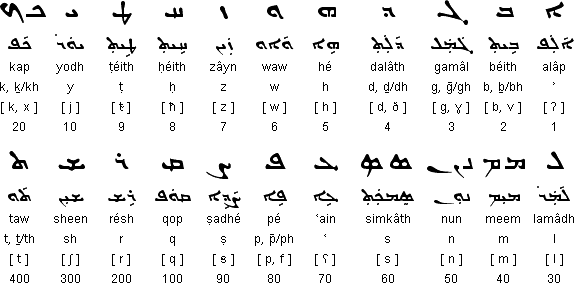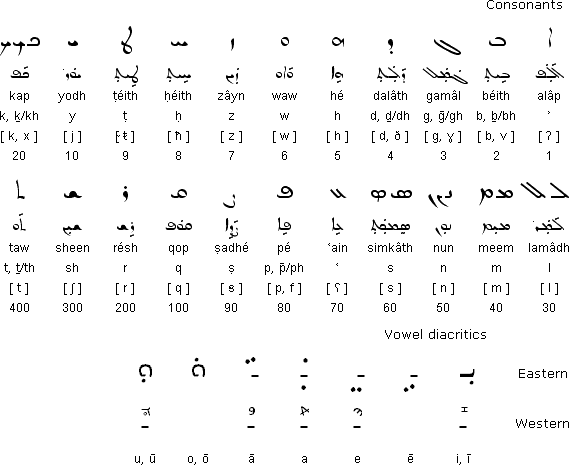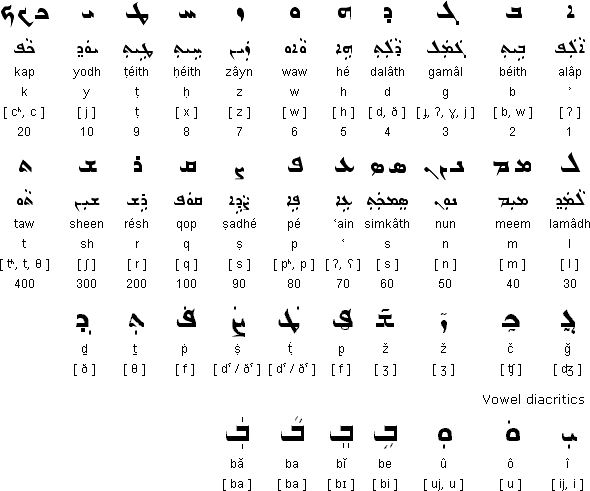![]()
Syriac alphabet
The Syriac alphabet developed from the Aramiac alphabet and was used
mainly to write the Syriac language from about the 2nd century BC.
There are three major forms of the Syriac alphabet: Esṭrangelā
(ܐܣܛܪܢܓܠܐ), Serṭā
(ܣܪܛܐ) and Maronite. Esṭrangelā, meaning
‘rounded’, is the oldest form and is now used mainly in scholarly publications,
titles and inscriptions. Serṭā (‘line’) is usually used to write
the West Syriac dialect and developed during the 8th century AD. Maronite,
which is also known as Jacobite, and developed after
Many other scripts developed directly or indirectly from the Syriac
scripts, including Nabatean,
Palmyran, Mandaic, Parthian,
Pahlavi, Sogdian, Avestan
and Manichean.
Notable features
- Type of writing system: abjad
- Direction of writing: right to left in horizontal lines.
- Number of letters: 22 consonants, plus diacritics
- Used to write: Aramaic, Syriac and Assyrian Neo-Aramaic
- Letter forms change depending on their position in a word.
- There are no symbols for numerals. Instead each letter has a numeric value.
- Syriac scripts are usually written pointed (with vowel diacritics)
but can also be written unpointed (without vowel diacritics).
Used to write:
Aramaic, a Semitic language that was the lingua franca of
much of the Near East from about 7th century BC until the 7th century AD, when it
was largely replaced by Arabic. Classical or Imperial Aramaic was the
main language of the Persian, Babylonian and Assyrian empires and spread
as far as Greece and the Indus valley.
After Alexander the Great destroyed the Persian Empire, Aramaic ceased
to be the official language of any major state, though continued to
be spoken widely. It was during this period that Aramaic split into
western and eastern dialects.
Aramaic was once the main language of the Jews and appears in some of the
Dead Sea Scrolls. It is still used as a liturgical language by Christian
communities in Syria, Lebanon and Iraq, and is still spoken by small numbers
of people in Iraq, Turkey, Iran, Armenia, Georgia and Syria.
Aramaic has also been written in versions of the
Latin,
Hebrew and
Cyrillic alphabets, though
the Syriac is the most widely used script to write Aramaic.
Syriac, an eastern dialect of Aramaic spoken by Christians
in the lands in between the Roman and Parthian empires between the 1st and 12th
centuries. Syriac is still used used nowadays as ritual and literary language
by speakers of Neo-Aramaic in Syria. It is also used for sermons in Syrian churches
in the southern Indian state of Kerala. Syriac has also been written with the
Uyghur alphabet.
Assyrian Neo-Aramaic, a diverse group of Eastern Aramaic/Syriac
dialects spoken by about 200,000 people mainly in Iraq, Syria, Iran, Armenia,
Georgia and Turkey. The Syriac, Latin and Hebrew scripts are all used to write
Assyrian Neo-Aramaic.
Estrangelo

Western, Jacobite or Serto script

Eastern or Nestorian script

Notes
The letters kap and nun have three different forms, the one on the right
is used in initial and medial positions, the one in the middle is used
in final positions when connected to a previous letter, and the one
of the left is used in final positions when unconnected to a previous
letter. In Estrangelo the letter kap only has a different shape when in
initial position.
The letters meem and simkâth have one form for initial and medial
positions (right) and one form for final positions (left).
In the Serto script the letter lamâdh has a different initial form.
The vowel diacritics for î, ô and û are always attached
to the letters y and w, while other vowels diacritics can be attached
to any consonants.
Sample text (Syriac)

Translation
Glory to Him who has glorified and exalted the Syriac language in His holy
mouth, and [who] entrusted and handed over His life-giving teachings to His
blessed apostles in Syriac; and the renowned forefathers and the skilled
teachers of His Church have constituted and composed her beautiful liturgies
in Aramaic, and explained and translated the living words of His salvation-bringing
Gospel in the same [language].
Translated into English by Dirk Bakker
Longer sample text (Tower of Babel)
Sample text (Assyrian Neo-Aramaic)

Translation
All human beings are born free and equal in dignity and rights. They
are endowed with reason and conscience and should act towards one another
in a spirit of brotherhood.
(Article 1 of the Universal Declaration of Human Rights)
